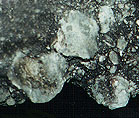These are single celled organisms with well defined organelles, such as the nucleus, living singly or in colonies. The kingdom includes some ten phyla, several of which lack a good fossil record. These phyla, like those of the Procaryota Kingdom, include animals which are mostly microscopic. One phylum, the Protozoa, includes larger, macroscopic organisms, which have considerable importance as index fossils.
- Phylum PROTOZOA
Class SARCODINA
- Order FORAMINIFERA
- Family FUSULINIDAE
- (the fusulininds)
 The
tests (shells) of fusulinids are small (up to 1 cm). They are football
shaped and resemble fossilized grains of wheat or rice. They are
particularly useful as index fossils of the Late Paleozoic, and became
extinct at the end of this era.
The
tests (shells) of fusulinids are small (up to 1 cm). They are football
shaped and resemble fossilized grains of wheat or rice. They are
particularly useful as index fossils of the Late Paleozoic, and became
extinct at the end of this era.- THE NUMMULITES
(several families)

 These
are the largest of all foraminifera and some have tests (shells) the size
of dinner plates. Their tests are generally discoidal (disk-shaped, vaguely
like a coin). Taxonomically, they belong to several families.
They are important for the zonation of the Late Mesozoic and the Cenozoic.
They are a common fossil in the limestones of Florida. More
on nummulites
These
are the largest of all foraminifera and some have tests (shells) the size
of dinner plates. Their tests are generally discoidal (disk-shaped, vaguely
like a coin). Taxonomically, they belong to several families.
They are important for the zonation of the Late Mesozoic and the Cenozoic.
They are a common fossil in the limestones of Florida. More
on nummulitesOrder RADIOLARIA
.
Radiolarians are microscopic in size and many species are planktonic (free moving near the surface) Their remains settle to the ocean floor to make deep sea oozes.